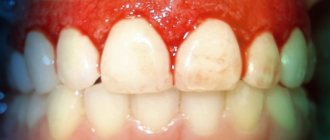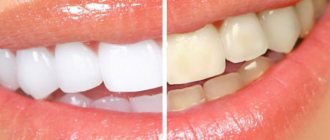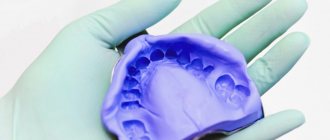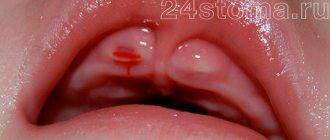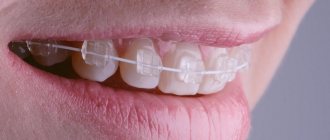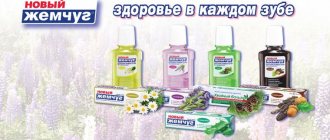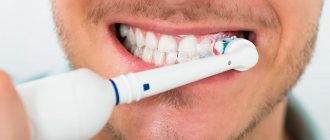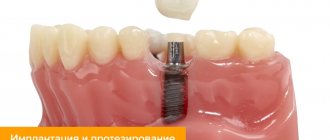Dental deposits are plaque and tartar that form on the surfaces of teeth and accumulate in the supragingival and subgingival space. Dental plaque not only makes our teeth unsightly - dull and yellow, but they contribute to the development of a wide variety of dental diseases of the teeth and gums. It is for this reason that it is imperative to remove dental plaque and do it in the dentist’s office, using professional techniques and equipment.
How dental plaque is removed in dentistry, by what methods and what is the price for the service in Moscow - we will answer all these questions in detail in this article.
What is dental plaque and how is it removed in dentistry?
Dental plaque is plaque that remains on the teeth after eating or drinking. This plaque contains large quantities of various bacteria and pathogenic microorganisms that harm the health of our teeth and gums. If soft dental deposits are not removed by regular brushing, they will gradually harden and turn into stone, which cannot be removed at home. Both hard and soft deposits on teeth increase the risks of developing caries, periodontitis and periodontal disease. Therefore, you need to deal with their timely removal.
Some people think that brushing their teeth every day will be enough to completely remove plaque, but this is not true. Even if you carry out dental hygiene according to all the rules and using all the recommended tools (brushes, brushes, floss), you will still not be able to carry out high-quality removal of deposits from hard-to-reach places in the oral cavity - interdental spaces, in the space above and below the gums. For this reason, to remove dental plaque, you need to go to dentistry and carry out the procedure using professional techniques and instruments.
To remove dental plaque in modern dentistry, various methods are used, and below we will consider in detail the most popular methods of cleaning teeth and the oral cavity from plaque and tartar.
Calculate the cost of treatment by taking a short test in 20 seconds!
Do not delay your treatment, because in this matter time plays against us.
The essence of the Air Flow procedure
The teeth cleaning procedure is carried out in a dental clinic by a qualified specialist. The method was developed by the Swiss company EMS (Electro medical system). The cleaning tool is the Air Flow hardware system. The device allows you to thoroughly, but very carefully in relation to the enamel layer, clean the most inaccessible places in the dentition (interdental spaces, “eights”, etc.). The essence of the method is the directed spraying of a mixture of water, compressed air and a soft abrasive substance (sodium bicarbonate) onto the surface to be cleaned. The solution is supplied under pressure, so the accumulated plaque is peeled off from the enamel and washed off. The power of the jet is adjusted by the dentist depending on the degree of contamination. This treatment does not scratch the enamel layer, since the smallest abrasive particles have a rounded shape.
Removing dental plaque: methods used in modern dentistry
To remove dental plaque in dentistry, physical and hardware methods can be used. In the first option, special tools are used to remove deposits - stone and plaque - hooks, scalers, finishers. However, the physical method of removing dental plaque is used quite rarely, only when there is a need to remove tartar from deep gum pockets, from which it is difficult to remove it in other ways.
Why has removing dental plaque with hand instruments become unpopular among modern dentists? It's simple, this method is less advanced than modern technologies for removing plaque and tartar. Manual removal of dental plaque is a labor-intensive process, the effectiveness of which will largely depend on the level of knowledge and qualifications of the dentist. Moreover, when manually removing dental deposits, irregularities remain on the teeth, in which plaque will accumulate even more actively.
Due to the considered disadvantages, manual removal of dental plaque is rarely carried out; hardware methods for removing plaque and tartar are more often used - Air Flow technology and ultrasonic cleaning.
Air Flow technology for removing dental plaque
This technology is ideal for removing soft and pigmented deposits from tooth surfaces.
The procedure for removing plaque is quick and without discomfort for the patient and, in addition to removing plaque, it helps to lighten the tooth enamel a little - by approximately 2-3 shades, to its natural shade. When removing dental plaque using Air Flow technology, teeth are cleaned by applying a powerful air-water flow to their surface, which contains abrasive particles (soda).
Air Flow dental plaque removal is an effective and gentle method of combating plaque, but with all its advantages, it does not help get rid of tartar. To carry out high-quality removal of hard dental deposits, teeth are cleaned with ultrasound. We will talk about this technology in detail in a separate section of our article.
How does Air‑Flow teeth cleaning work?
The Air‑Flow teeth cleaning device delivers a special mixture under high pressure in a directional manner. It consists of fine abrasive powder, water and air.
The jet delicately and thoroughly removes plaque from the enamel without damaging it. As a result, the teeth become smooth and brighten by 1–2 shades. But the Air-Flow method is not teeth whitening: the brightening effect is achieved by removing the soft bacterial film that causes teeth to become dull. With the disappearance of this film, their natural color returns.
Result of Air‑Flow teeth cleaning
- The enamel becomes smooth, and plaque practically does not settle on it
- Teeth brighten, acquire a natural shade and shine
- Bad breath disappears, breath becomes fresh and healthy
Ultrasound removal of dental plaque: features, stages and prices
Ultrasound removal of dental plaque is a modern and highly effective method of oral hygiene. Ultrasound will help:
- Carry out the removal of supragingival and subgingival tartar;
- Quickly remove pigmented plaque;
- Eliminate soft microbial plaque.
Removing dental plaque is a procedure that is carried out in three stages. Below we will tell you in detail how the process of removing dental plaque with ultrasound will take place in the dentist’s office.
STEP 1: Ultrasound removal of plaque and tartar
Ultrasound removal of dental plaque is carried out using special equipment - ultrasonic scalers.
Scalers can be either a separate device or part of a dental unit. The main working element of the scaler is its tip with a metal attachment. The tip of this metal nozzle vibrates at high frequencies in the ultrasonic range. Also, water is supplied through the nozzle, which washes away decayed dental plaque from the patient’s mouth and is immediately removed with a saliva ejector.
Free consultation on the cost of treatment in our dentistry
Leave a request and the clinic administrator will contact you within 15 minutes!
The scaler effectively removes dental plaque because:
1. Its nozzle creates oscillatory movements that destroy plaque and tartar. In order for the removal of dental plaque to be carried out efficiently and without damaging the teeth, it is extremely important that the vibrations of the nozzle are directed along the dental surfaces.
2. During the operation of the scaler, water is supplied to the oral cavity, which is needed not only to wash out destroyed deposits and cool the nozzle. Ultrasound in an aqueous environment creates many small bubbles, which immediately burst, releasing a large amount of energy. This energy promotes improved removal of dental plaque from tooth enamel, and in addition, helps eliminate pathogenic microflora in the oral cavity.
After removing plaque, the second stage of ultrasonic cleaning is carried out - teeth polishing.
STEP 2: Polishing teeth after removing dental plaque with ultrasound
Polishing teeth after removing dental plaque is an event that must be carried out without fail.
After removing deposits with ultrasound, microscopic particles of plaque and stone may remain on the dental surfaces, making the tooth enamel uneven and rough, which will provide optimal conditions for the accelerated accumulation of a new layer of plaque. Polishing teeth after removing deposits can be done with hand tools, but most often the Air Flow technology is used for polishing, which we briefly told you about above. When manually polishing teeth, after removing plaque, pastes, brushes and strips are used - thin strips with an abrasive layer, which polish the space between the teeth.
STAGE 3: Remineralization of teeth after removal of plaque and tartar
This stage is not considered mandatory and, moreover, many clinics do not include it in the procedure for professional removal of dental plaque.
However, remineralization must be carried out after removing plaque and tartar from the teeth. It helps strengthen tooth enamel and relieve sensitivity that may occur in the neck area of teeth after plaque removal. Remineralization of teeth is carried out immediately after removing plaque and tartar and uses special preparations based on sodium fluoride.
Useful tips
The greatest effectiveness of teeth cleaning is ensured by positioning the nozzle at an angle of 10°-60° to the enamel surface. The distance between the nozzle and the tooth surface should be 3-5 mm. The air-abrasive flow is directed from the cutting edge of the tooth to the gum.
Since we are talking about a rapid flow of small abrasive particles that, if used incorrectly, can cause harm to the patient’s mucous membranes, eyes and respiratory system, the following rules must be followed:
- The patient, operator and assistant should use gauze masks and safety glasses. If the powder gets into your eyes, rinse them with water and consult an ophthalmologist.
- It is recommended to use effective suction of oral fluid along with abrasive and particles of destroyed plaque and dirt.
- To protect the lips, Vaseline is applied to them.
- Do not direct the jet at cement and tooth roots, demineralized enamel, fillings and dentures.
- From time to time, you need to take a break from the procedure to rinse the patient's mouth.
- Dry and clean air of standard pressure must be used. Humidifying the powder with air can cause it to harden.
- The lid of the powder container must be tightly closed; during operation, you must not knock on the container to avoid damaging it and opening it.
- Only the contents of one Flash Pearl sachet are poured into the container. The bag should be opened immediately before pouring the powder into the container (to prevent it from getting wet). At the end of the procedure, the container must be cleaned of powder residues.
- Only NSK branded powder should be used.
- It is necessary to thoroughly dry the device and all its internal and external surfaces before adding powder.
- If the patient has contact lenses, they are removed before the procedure.
Dryness and cleanliness of the system and the air used are the most important conditions for using the device. Excessive humidity and contamination can cause the abrasive to harden and render Prophy Mate unusable.
The video provides additional information on the topic of the article.
Advantages of ultrasonic dental plaque removal
Ultrasound removal of plaque and tartar has a number of advantages. First of all, it is worth noting the high efficiency and versatility of the technology: it is ideal for removing pigmented plaque and perfectly removes stone from the most inaccessible areas of the oral cavity, even from deep periodontal pockets.
Removing plaque and tartar with ultrasound helps destroy pathogenic microflora in the oral cavity and, what is especially important, cleans periodontal pockets from pathogenic bacteria.
A clear advantage of removing dental plaque with ultrasound is the affordable cost of the procedure. On average, you will have to pay 4-5 thousand rubles for removing plaque and tartar, polishing and remineralizing teeth.
Are there any disadvantages to ultrasonic tartar removal?
There are no downsides to the technology of removing tartar using ultrasound - it is the most modern and effective method of professional oral hygiene. However, before you go to the dentist’s office to remove tartar with ultrasound, you should find out the level of competence of the doctor, as well as the level of equipment of the clinic.
Why is it important? The fact is that if the removal of tartar and plaque from teeth is carried out by an inexperienced or illiterate specialist, or using outdated equipment, there is a high risk of damage to tooth enamel and poor quality of cleaning them from deposits.
How to preserve the results of dental plaque removal for a long time?
In order for the positive results of cleaning to last for a long time after removing plaque and tartar, you need to learn how to properly care for your teeth. Here are the recommendations that dentists give to their patients:
- Choose and use in dental and oral hygiene the brush and paste that suits you - your type and condition of tooth enamel;
- Brush your teeth at least twice a day - before breakfast and before bed. Try to rinse your mouth after every meal; • Brush your teeth in a circular motion for 3-5 minutes;
- Use rinses and dental floss to remove plaque from interdental spaces and other places in the mouth that are difficult to clean with a regular brush;
- Teeth need to be brushed from all sides, in addition, the tongue and gums need to be cleansed;
- Try to drink coffee and tea less often, and it’s better to quit smoking altogether. It is these habits that contribute to the rapid formation of pigmented plaque.
And of course, don’t forget that professional dental plaque removal is a procedure that should be carried out at least twice a year!
Air abrasive polishing. Literature review
Sarah J. Graumann , RDH, BS, MDH,
Michelle L. Sensat , RDH, MS
Jill L. Stoltenberg , BSDH, MA, RF
Translation: Ekaterina Stankevich
Introduction
Air abrasive polishing provides an alternative method for removing supragingival external pigmentation and deposits on teeth. Unlike traditional mechanical polishing (with a rubber cup containing a prophylactic paste), air abrasive polishing uses a lightweight tip, similar to an ultrasonic scaler, that generates a mixture of compressed air, abrasive powder and water to remove biofilm and pigments. Air polishing was first introduced to the dental community in the late 1970s. The first air abrasive polisher (AAPA) Prophy Jet Marck IV™, under the Dentron brand. Since that time, a large number of VAPAs have been developed. Past research has confirmed that, when used correctly, air polishing can provide a safe, effective and modern approach to removing biofilm and stains from teeth. The advantages of air polishing over cup cleaning are considered to be saving time and effort for the doctor and more effective removal of pigments. Based on research data, this technique was introduced into practice. However, most clinics continue to rely on traditional polishing techniques.
Modern developments in air abrasive polishing have led to the need to update literature reviews (from 1999 to 2012) with recommendations from scientific communities for its use. This review will discuss new powders, the effectiveness of the technology, effects on soft and hard tissues, restorations, sealants, orthodontic appliances and implants, as well as health risks and contraindications for air polishing. Based on the latest literature, the review will help the reader to use the proposed protocols in clinical practice.
Powders for air-abrasive polishing
Powders based on sodium bicarbonate (NaHCO3)
were the first abrasives in air polishing. NaHCO3 powders are specially processed soda particles up to 250 microns in size. Studies have confirmed the safety and effectiveness of supragingival baking soda compared to traditional scaling and rubber cup polishing. While no enamel damage has been reported, scientists and manufacturers have cautioned against its long-term use on root cementum, dentin, and some restorative materials such as composites.
Current developments in abrasive powders include the use of glycine, sodium calcium silicophosphate (Sylc™; OSspray, London, UK), calcium carbonate (Prophypearls™; KaVo, Charlotte, NC), and trihydroxyaluminum (Jet–Fresh™; DENTSPLY, York, Penn ). Manufacturers of glycine, sodium calcium silicophosphate and calcium carbonate market their powders as less abrasive than traditional soda powders. Glycine is a naturally occurring amino acid. It is water soluble and has no salty taste. Clinpro™ glycine powder (3M™ ESPE™, Seefeld, Germany) has a particle size of up to 63 microns, which is almost 4 times smaller than soda particles. Pelka et al found that glycine powder was significantly less damaging to the surface of restorations than soda powder (Acclean Air Preventive Powder™; Henry Schein, Lange, Germany, and Air–Flow Prophylaxis Powder™; EMS, Nylon, Switzerland). Like baking soda powder, glycine removed plaque more effectively than hand instruments.
Historically, the use of air abrasive polishing has been limited to the supragingival area. However, in recent years, in vivo studies have demonstrated the effectiveness of glycine powder when used in both the subgingival and supragingival areas.
Petersilka et al compared the use of hand instruments and air abrasive polishing with glycine for subgingival plaque removal and noted that glycine was superior to hand instrumentation in periodontal pockets 3–5 mm deep. The marked reduction in CFU values following its use was attributed to a combination of air, pressurized water spray and soft abrasive powder, where the powder was the key factor in bacterial reduction.
Gum erosions from exposure to glycine powder have also been studied. When the nose of the tip was pointed at an angle of 60-90 degrees to the tooth surface for 5 seconds, the appearance of erosion was minimal. Petersilka et al suggested that glycine powder may be less traumatic to the gums than hand instruments and soda polishing. All areas of erosion healed within 14 days after treatment.
Sodium calcium silicophosphate powder (Sylc™; OSspray, London, UK) is a bioactive glass developed specifically for air abrasive polishing. It contains natural components such as calcium, phosphorus, silicon and sodium. The manufacturer says that bioactive glass causes the regeneration of damaged areas of the tooth surface, creating an enamel-like layer when used in dental products, and has a deeper whitening effect as a polishing agent compared to soda. To date, in vitro studies have been carried out and there are no in vivo studies. The properties of the drug allow it to reduce dentin hypersensitivity, as well as cope with biofilm and pigmentation. Studies by Sauro et al confirmed the ability of CaNaO6PSi to reduce hypersensitivity through dentinal tubule occlusion during air abrasive polishing or traditional brush and paste polishing. This mechanism is similar to the action of NaHCO3. Another study found that CaNaO6PSi was more effective than soda in reducing hypersensitivity. Banerjee et al found that CaNaO6PSi provided statistically significant improvement within 10 days of treatment, whereas sensitivity increased in the same patients after baking soda.
Calcium carbonate (CaCO3) (Prophypearls™; KaVo, Charlotte, NC) is an abrasive powder with spherical crystals. It was assumed that the same spherical shape of the crystals minimizes the abrasive effect compared to the different shapes of particles in other powders. The 45 micron particle size of CaCO3 is smaller than baking soda but similar to glycine. But while studies show the effectiveness of CaCO3 in removing pigmentation, the defects that the powder leaves on the dentin of the tooth root were greater than those caused by baking soda. Therefore, more research is required to determine the abrasive properties of CaCO3.
Aluminum hydroxide (Al(OH)3) (JET–Fresh™; DENTSPLY, York, Penn) may serve as an alternative abrasive for patients with dietary soda restrictions. Aluminum hydroxide particles are harder but similar in size to baking soda.
Johnson et al found that Al(OH)3 should be avoided on the surface of composite restorations, GIC and luting cement.
Inorganic salts have also been studied as polishing agents. Petersilka et al combined non-toxic, biocompatible, water-soluble organic and inorganic salts with different particle sizes and shapes to create new powders. Use parameters included a combination of 2mm, 4mm or 6mm distance from the tooth surface with varying powers. The root damage values for all 4 abrasives were less than for soda. However, at the time of writing, the powders were not yet commercially available.
Efficiency of use
Early studies of soda-based powders demonstrated their high effectiveness in removing supragingival pigments, reducing operator energy costs, and being more time-efficient than brush and paste polishing. Botti et al reported that air polishing was better at removing biofilm and debris from pits and fissures than synthetic brushes before sealing. In addition, this work demonstrated the benefits of air polishing for improving the microflora of small periodontal pockets. It has been proposed to replace sonic and ultrasonic scaling, as well as manual subgingival plaque removal, with air abrasive polishing, which has been shown to be significantly more effective in removing subgingival bacteria compared with hand instruments.
Over the past 10 years, a large number of air polishing machines have appeared on the market. In addition to traditional stand-alone devices, convenient tips for installation have appeared. The tip noses for subgingival polishing have been improved. There are several studies on the comparative characteristics of different models.
Recent studies have calculated the powder consumption of various devices per unit time in order to determine the dependence of the consumption on the amount of powder in the tank and the settings of the device. The devices studied were Air Flow® (Electo Medical Systems, London), CaviJet® (DENTSPLY, York, Penn), Air Max® (Satellec, Merignac, France) and the Prophyflex II® (KaVo, Biberach, Germany). Air Flow® and Cavi–Jet® showed an increase in powder consumption with increasing power. The Air Max unit showed comparable values at low and medium power, but 5-12 times greater consumption at high power. With Prophyflex II®, the flow rate was independent of the selected settings. The authors concluded that the effectiveness of air polishing depends largely on the amount of powder in the reservoir. Doctors are advised to monitor the consumption of powder, replenishing it in time during the treatment process.
The effects on dentin were compared among different devices. Pelka et al showed in in vitro studies that the damaging effect of Prophyflex3 on dentin is significantly higher than that of EMS devices.
Impact on soft tissue
Recent reviews indicate studies where bleeding gums and a salty taste in the mouth after air polishing were noted. However, after 2 weeks there were no signs of gum injury. Modern research confirms this. Histological examination of the marginal gums in dogs after treatment with soda powder revealed erosive changes in the keratin and epithelial cell layer. The degree of damage correlated with the time of exposure. Kozlovsky et al suggested limiting the exposure time to the tooth surface to 5-10 seconds to minimize damage to the epithelium and prevent exposure of connective tissue.
Most studies examined operating parameters ranging from 5 to 20 seconds. Moreover, it was shown that polishing with glycine caused significantly less damage to the epithelium within 5 sec than when using soda powder or manual curettes. In addition, glycine can be used for polishing and removing biofilm in the subgingival part of the root.
In vivo studies have shown that glycine is safe and does not cause significant gingival damage.
IMPACT ON ENAMEL, DENTIN AND CEMENT
Literature examining the effects of baking soda powder on enamel, dentin, and cementum has generally reported that the latter is safe for enamel without causing significant damage to it and less abrasive than a rubber cup with pumice. The studies paid attention to caution when working with dentin and cement. To avoid damaging it, polishing should be limited exclusively to the enamel. Agger et al confirmed this in recent studies of the abrasiveness of soda powder using scanning microscopy and laser profilometry.
New polishing powder formulations have been investigated for safety on the exposed root surface. Pelka et al showed that exposure to glycine powder caused markedly less damage to the root surface compared to soda and calcium carbonate powders. Moreover, the use of the EMS device was more gentle than Prophyflex 3®. Petersilka et al studied the damaging effects at various operating parameters of the devices. They used soda powder and noted the depth and volume of defects on the root from fine, medium and high grit powder, exposed for 5, 10 and 20 seconds at a distance of 2.4 and 6 mm at an angle of 45 and 90 degrees at various water settings. The results showed that it was the time of exposure to the surface that had the greatest influence, and not the choice of powder or water supply. The distance from the nozzle had a negligible effect in this study. The conclusion was that it was inadmissible to use soda powder on the exposed root surface.
Tada et al studied the abrasiveness of glycine powder with particle sizes of 63 and 100 microns. Larger particle sizes caused less damage. Additional research is needed to determine the cause of this phenomenon. New research by Tada et al was devoted to studying the influence of the distance from the nozzle to the surface on the formation of defects. They found that a spray from a distance of 6 mm at an angle of 45 degrees forms the smallest defects in depth. Measurements were also carried out at distances of 2, 3, 4 and 5 mm. In addition, 65 micron glycine powder forms significantly smaller defects in depth and volume than 65 micron soda powder and even 25 micron glycine powder. Scientists hypothesized that heavier particles do not have time to reach maximum speed after leaving the nozzle before hitting the dentin.
Effect on restorations, sealants, orthodontic appliances and implants
Past studies have found that the use of baking soda powder causes damage to the surface of composite and ceramic restorations. However, it is noted that clinicians should follow the recommendations of the manufacturers' instructions. Modern studies of new powders have shown that composite and ceramic restorations also have a slight but noticeable loss of material. Ultrasonic tips damage the amalgam surface much more than soda powder. Using a pressure of 20 psi results in less damaging effects of baking soda on the surface of any restoration (previous studies used a pressure of 60 psi). Glycine powder on the surface of nanohybrid restorations leaves smaller traces (1-2 microns) than soda powder (5-10 microns).
Air polishing is preferred when preparing the tooth for sealing with sealants before brushing and paste cleaning. It allows you to increase the adhesive bond strength and penetrate the material deeper into the enamel surface.
Pelka et al found that the treatment of sealants with powder during air polishing irreversibly damages the surface of the material, and soda to a greater extent than glycine. Other studies have confirmed these findings. The main takeaway is that once teeth are coated with sealants, air polishing should be avoided on that surface.
When polishing patients with braces, it is necessary to avoid getting powders on the surface of the grooves of metal or ceramic braces, as this will further increase friction between the arch and the bracket. No difference in the damaging effects of soda and glycine was detected under a spectral microscope. As for plastic braces, only baking soda powder can damage them. Glycine does not leave any traces on plastic.
When treating peri-implantitis, air polishing creates an even, smooth surface, stops the growth of dental plaque and completely removes bacteria. Recent studies have shown the superiority of glycine powder over mechanical cleansing with curettes and chlorhexidine in reducing bleeding after 6 months. While they showed a decrease in the depth of the pockets and the amount of attachment after 6 months turned out to be the same for both methods of debridement.
Health and Safety
The use of soda water polishing is contraindicated if you are on a sodium-free diet, hypertension, respiratory disease, infectious disease, renal failure, Addison's disease, Cushing's disease, metabolic alkalosis, or taking the following medications: mineralocorticoid hormones, anti-diuretics, and sodium supplements.
Contraindications such as a sodium-free diet, hypertension and renal failure do not apply to modern powders without soda - these are glycine, calcium carbonate and aluminum hydroxide. Calcium sodium phosphosilicate contains a small amount of sodium and does not have a salty taste. Therefore, sodium restrictions do not apply to it. But it is not recommended for patients with silicon allergies.
Very rarely, air polishing can cause conditions such as air emphysema, subcutaneous facial emphysema and pneumoparotitis. Between 1977 and 2001, Health Device Alerts reported 9 cases of air emphysema and 3 cases of air embolism associated with air polishing. Since then, 6 more cases of similar complications have been published.
Gutmann suggested some universal precautions to take to reduce health risks include using a powerful vacuum cleaner instead of a saliva ejector and rinsing with antiseptics before treatment. These recommendations are still relevant today. Adherence to these protocols ensures that there is little chance of complications from using the aerosol. There are no adverse health effects associated with the use of glycine, calcium carbonate, or calcium phosphosilicate in the literature of this review.
A special Jet-Shield™ device for reducing aerosol levels was introduced by Dentsply in 1998.
Since that time, only one study has examined the effectiveness of Jet–Shield™. This work showed a significant reduction in the number of colony forming units on the operator's mask when using Jet–Shield™. Therefore, recommendations were given to use this device for air polishing.
Application in practice and clinical protocols
According to recent literature reviews, air polishing is considered a worthy alternative to traditional polishing in the modern clinic. Air polishing has been found to be more effective than traditional polishing in removing pigmentation and supragingival biofilm. New low-abrasive powders can be used on the surface of root cementum, dentin and various restorative materials without unnecessary damage. Based on this review, we conclude the benefits of using glycine powder in terms of creating minimal defects on the dentin surface, restorations and gingival erosion. Traditional rubber cup polishing requires the clinician to consider the abrasiveness of the paste, the pressure applied to the tip, and the type of surface being polished. When air polishing, the pressure is always the same, eliminating variability. However, research indicates that it is necessary to control the filling of the powder reservoir during operation for optimal operating results.
Aerosols are constantly generated at receptions due to various procedures. To eliminate aerosol during air polishing, it is better to use a vacuum cleaner; a saliva ejector is used to a limited extent. Standard infection control procedures along with antiseptic rinses prior to the procedure are a prerequisite for using the technique. Optimal angulation and distance to the tooth when applying the powder will help avoid emphysema and gum trauma. There are no other requirements for using this technique in patients. Restrictions apply to the use of soda in patients on a sodium-free diet and with hypertension. Other types of powders described are suitable for them. The use of aerosol reduction devices such as Jet–Shield™ will reduce the risks in patients with respiratory conditions.
As previously mentioned, antiseptic rinsing is a standard protocol to prevent cross-contamination and reduce bacterial load during the procedure.
Trends and future research
Growing interest in the effective removal of subgingival biofilm has led to significant improvements in the air polishing procedure. Glycine-based powders have become an option due to their low abrasiveness, gentleness on gum tissue and restorations, and the ability to be used both above and below the gum. With additional research (which has already been carried out, translator's note), glycine promises to revolutionize the stage of maintenance periodontal treatment. To effectively use air polishing, the clinician must be trained, aware of its advantages and disadvantages, indications and contraindications.
Conclusion
This literature review demonstrated the need for air polishing in current practice. When used correctly, it is effective and safe. Newer polishing powders such as glycine (and erythritol) are less abrasive and can be used during maintenance treatment in patients with minor periodontal involvement.
In removing subgingival biofilm, the method is superior in quality and efficiency to manual scaling, and is more economical in time and material costs and in terms of the potential treatment outcome.
Future studies should focus on reducing aerosol generation, increasing safety for restorations and for all patients, regardless of their medical status.
Source: jdh.adha.org
Is it harmful - ultrasonic removal of dental plaque?
Many patients are interested in the question of the safety of ultrasonic removal of dental plaque. We hasten to reassure you - the safety of the procedure has long been proven and confirmed by a number of clinical studies. The use of ultrasonic equipment to remove plaque and tartar from teeth does not cause any negative side reactions or pathological changes in the human body.
However, it is worth considering that there are a number of contraindications to the procedure that must be taken into account. Ultrasound removal of dental plaque should be avoided if you have serious pathologies of the heart and blood vessels, severe respiratory diseases, pathological tooth sensitivity, and ultrasonic teeth cleaning is not performed in children and adolescents.
During pregnancy, it is possible to remove dental plaque with ultrasound, but not in the first trimester.
Calculate the cost of treatment by taking a short test in 20 seconds!
Do not delay your treatment, because in this matter time plays against us.
Indications and contraindications
Indications:
- Prevention of caries
- Before dentures with crowns or implants (for correct selection of denture color)
- Before installing braces
- Before performing ZOOM-4 whitening (to obtain a uniform effect)
- When symptoms of periodontal disease appear
- The need to clean the braces system
- Pigmentation of enamel with natural or artificial dyes
- Excessively crowded arrangement of elements in the dentition
Contraindications:
- Allergy to baking soda
- Children's age (up to 10 years)
- Diseases of the ENT organs accompanied by nasal congestion
- Bronchial asthma
- Chronical bronchitis
- Inflammation of gingival tissue in acute form
Cost of dental plaque removal
We have already written above that this procedure has a cost that is quite affordable for a wide range of patients. But in different clinics the price may be different: this is explained by the fact that different dentists include a different set of procedures in the dental plaque removal service. Most often, a complex is offered that includes ultrasonic teeth cleaning, Air Flow polishing and fluoridation. The cost of such a comprehensive service in Moscow will start at 4,500 rubles.
You can undergo the procedure for removing dental plaque in comfortable conditions and using ultra-modern technologies and equipment in our dental clinic in Moscow - VENSTOM. You can find out all the details about the service and about making an appointment with our specialists by writing to the chat on our website or calling us!


